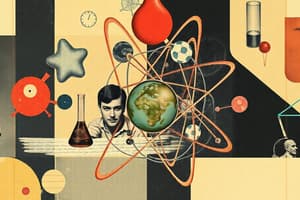Podcast
Questions and Answers
If Democritus's atomic theory had been widely accepted, how might the progression of atomic discovery have differed?
If Democritus's atomic theory had been widely accepted, how might the progression of atomic discovery have differed?
- The discovery of the electron would have preceded the concept of indivisible atoms.
- The concept of elements would have been delayed indefinitely.
- Experimental validation of atomic structure would have occurred much earlier. (correct)
- Scientists would have focused on disproving the existence of atoms.
How did the results of the Cathode Ray Tube experiments by Thomson and Goldstein contribute to the understanding of atomic structure?
How did the results of the Cathode Ray Tube experiments by Thomson and Goldstein contribute to the understanding of atomic structure?
- They identified the nucleus as the central component of the atom, leading to Rutherford's model.
- They confirmed the indivisibility of atoms, supporting Dalton's model.
- They established the concept of electron orbits, forming the basis of Bohr's model.
- They demonstrated the existence of both positive and negative charges within the atom, disproving Dalton's model. (correct)
How did Rutherford's gold foil experiment change the atomic model proposed by Thomson?
How did Rutherford's gold foil experiment change the atomic model proposed by Thomson?
- It suggested the presence of a small, dense, positively charged nucleus surrounded by mostly empty space. (correct)
- It reinforced the idea of a uniformly dense atom with electrons distributed throughout.
- It disproved the existence of protons, suggesting the nucleus was composed of neutrons only.
- It introduced the concept of electrons existing in specific orbits around the nucleus.
If Chadwick had not discovered the neutron, how might the understanding of atomic mass have been affected?
If Chadwick had not discovered the neutron, how might the understanding of atomic mass have been affected?
How did Schrödinger's model improve upon Bohr's model of the atom?
How did Schrödinger's model improve upon Bohr's model of the atom?
Flashcards
Democritus
Democritus
A philosopher who proposed that atoms are indestructible and invisible.
John Dalton
John Dalton
Proposed that each element consists of tiny, solid, spherical particles called atoms.
Eugene Goldstein
Eugene Goldstein
Discovered the proton via the Cathode Ray Tube experiment, showing positive charge.
Ernest Rutherford
Ernest Rutherford
Signup and view all the flashcards
Niels Bohr
Niels Bohr
Signup and view all the flashcards
Study Notes
Early Atomic Concepts began with Democritus (400 BC), who proposed atoms as indestructible and invisible, but Aristotle rejected this idea. In the 19th century, John Dalton (1808) suggested that elements consist of tiny, spherical atoms. Eugene Goldstein (1886) discovered protons, while JJ Thomson (1897) discovered electrons and proposed the "plum pudding" model. In the 20th century, Ernest Rutherford (1911) identified the atomic nucleus, followed by Niels Bohr's (1913) model of electron orbits. Erwin Schrödinger (1926) introduced electron clouds, and James Chadwick (1932) discovered neutrons, explaining atomic mass discrepancies.
Studying That Suits You
Use AI to generate personalized quizzes and flashcards to suit your learning preferences.




